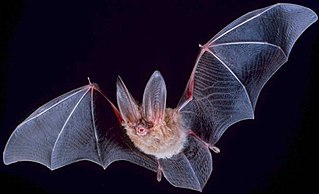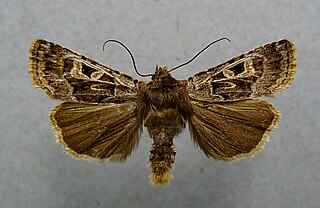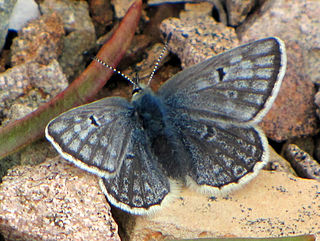
The autumnal moth is a moth of the family Geometridae. The species was first described by Moritz Balthasar Borkhausen in 1794. It is found throughout the Palearctic region and the Near East and has a much wider distribution than its two close relatives. In Sápmi (Lapland), in some years, the numerous autumnal moth larvae defoliate square miles of birch forests on mountains.
Agathiphaga is a genus of moths, known as kauri moths. It is the only living in the family Agathiphagidae. This caddisfly-like lineage of primitive moths was first reported by Lionel Jack Dumbleton in 1952, as a new genus of Micropterigidae.

Townsend's big-eared bat is a species of vesper bat.

The cloaked minor(Mesoligia furuncula) is a moth of the family Noctuoidea. It is found in the Palearctic realm (Europe, northwest Africa, Russia, Siberia, Japan, north Iran, Afghanistan, and China.

Eucarta virgo, the silvery gem, is a moth of the family Noctuidae. The species first described by Georg Friedrich Treitschke in 1835. It can be found in south, southeast and central Europe.

Mesapamea is a genus of moths of the family Noctuidae.

Oligia is a genus of moths of the family Noctuidae described by Jacob Hübner in 1821.

Charissa is a genus of moths in the family Geometridae.

Mesapamea secalis, the common rustic, is a moth of the family Noctuidae. The species was first described by Carl Linnaeus in his 1758 10th edition of Systema Naturae. It is found in Europe, north-west Africa, Turkey and northern Iran.

Chersotis ocellina is a moth of the family Noctuidae. It is found in the mountainous areas of Europe, especially in the Alps, the Apennine Mountains, Pyrenees and the Cantabrian mountains.

Agriades glandon, the Arctic blue or Glandon blue, is a species of butterfly in the family Lycaenidae. It in found in Eurasia and North America.

Eburia tetrastalacta is a species of beetle in the family Cerambycidae.
Mesapamea arbora is a species of cutworm or dart moth in the family Noctuidae first described by William Barnes and James Halliday McDunnough in 1912. It is found in North America.

Mesapamea secalella is a moth belonging to the family Noctuidae. The species was first described by X. Remm in 1983.

Perizoma lugdunaria is a moth belonging to the family Geometridae. The species was first described by Gottlieb August Wilhelm Herrich-Schäffer in 1885.
Cucullia balsamitae is a moth belonging to the family Noctuidae. The species was first described by Jean Baptiste Boisduval in 1840.

Pammene albuginana is a moth belonging to the family Tortricidae. The species was first described by Achille Guenée in 1845.

Stenoptinea cyaneimarmorella is a moth belonging to the family Tineidae. The species was first described by Pierre Millière in 1854.
Sideridis kitti is a moth belonging to the family Noctuidae. The species was first described by Schawerda in 1914.
Deuterogonia is a monotypic moth genus belonging to the family Oecophoridae described by Rebel in 1901. Its only species, Deuterogonia pudorina, was described by Wocke in 1857 as Gelechia pudorina.













